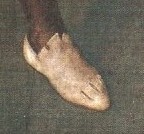In the second half of the 16th century shoes started to be closed again using a latchet. Latchet is an old term for a thong or similar used to fasten a shoe (1) . By the early 1600s, for the upper classes, royalty, nobility and gentry, the bows these latchets were tied into had disappeared behind huge shoe roses. They were still in place in 1640, but by 1660 they seem to have disappeared. This is an essay in details from paintings showing the rise and fall of the shoe rose. The links take you to an online version of the full painting.
 |
| 1577 |
So we start with Martin Frobisher’s shoe painted in 1577, in a style that had been around for some time. Are the the sort of “white leather pumps, 14d,” that the Petrie Accounts for 1569 list? (2)
.jpg) |
| 1597 |
Next we have a 1597 pair of shoes belonging to Robert Devereux, Earl of Essex with latchets tied in a small bow.
 |
| 1606 |
By 1613 his son, Prince Charles, has definitely got them. Somewhere about this time Ben Jonson wrote in his play Epicœne, or The silent woman (staged 1609, published 1616) “All the yellow doublets, and great roses i' the towne will bee there.”
 |
| 1613 |
| 1611 |
 Portraits from the Civil War show most frequently men in boots, but the shoe rose survived and can be seen in Peter Nason’s 1651 portrait of Walter Strickland.
Portraits from the Civil War show most frequently men in boots, but the shoe rose survived and can be seen in Peter Nason’s 1651 portrait of Walter Strickland.

 |
| 1613 |
Back to 1613 and Richard Sackville, Earl of Dorset. Now here we are lucky as an inventory of the Earl’s clothing dated 1617 exists, and the items appearing in this portrait have been tentatively identified. (3) Item 42 in the inventory is “Item one paire of roses of black ribban laced with gold and siluer lace. This is matched with Item 43 “one paire of white silke stockings embroadered with gold and siluer.”
 |
| 1636 |
King Charles is still wearing them with his robes of state in 1636, and his purchases in his Wardrobe accounts for 1633-35 show that roses were being matched with the garters and points, for example Thomas Robinson is paid for among others “One paire of rich needlework garters cinnamond cullour with roses and points suitable to them” (4)
 Portraits from the Civil War show most frequently men in boots, but the shoe rose survived and can be seen in Peter Nason’s 1651 portrait of Walter Strickland.
Portraits from the Civil War show most frequently men in boots, but the shoe rose survived and can be seen in Peter Nason’s 1651 portrait of Walter Strickland.The rose however did not survive the restoration. Charles II chose to be painted in the coronation portrait wearing shoes fastened with buckles, it was the beginning of the end. Although ordinary people had worn shoes with simple latchet ties for the whole period, and continued to do so until the end of the century, buckles were swiftly taking over. As Pepys said on the 22nd January 1660 “This day I began to put on buckles to my shoes, which I have bought yesterday of Mr. Wotton.”

1. OED. Oxford English Dictionary online version June 2012. [Online] 2012. [Cited: 10 August 2012.] http://www.oed.com/view/Entry/106043.
2. Cunnington, C. W. and P. Handbook of English Costume in the 16th century. London : Faber, 1970.
3. Peacham, H. The truth of our times. . London : s.n., 1618.
4. MacTaggart, P. and A. The rich wearing apparel of Richard, 3rd Earl of Dorset. Costume. 1980, Vol. 14.
5. Strong, R. Charles I's clothes for the years 1633-1635. Costume. 1980, Vol. 14.


